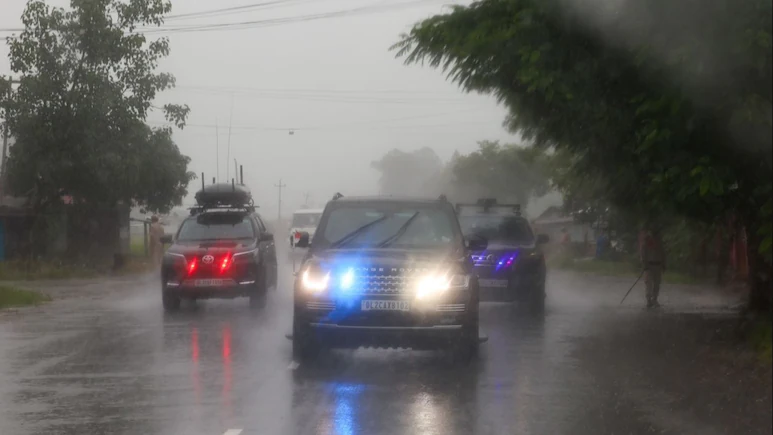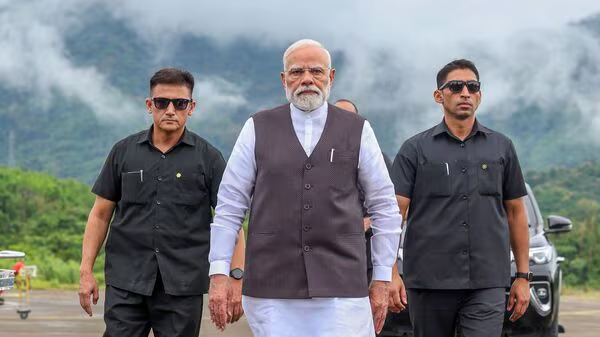Due to heavy rain in Manipur, PM Narendra Modi’s helicopter travel was canceled, and he opted to travel by car to Churachandpur. Read about the challenges faced, the purpose of his visit, and the impact of weather conditions on the journey.

PM Modi Travels by Car to Churachandpur as Rain Grounds Helicopter in Manipur
Heavy rainfall in Manipur disrupted Prime Minister Narendra Modi’s planned helicopter journey, forcing him to switch to road transport for his visit to Churachandpur. The adverse weather conditions, which have been affecting large parts of the Northeast, prevented aerial travel, highlighting the challenges of infrastructure and connectivity in remote regions during the monsoon.
Despite the unforeseen circumstances, PM Modi remained determined to continue his outreach and connect with the people in Churachandpur. His decision to proceed with the visit by car not only underscores his commitment but also reflects the resilience required in navigating challenging terrains and weather conditions in the region.
Weather Disrupts Helicopter Travel in Manipur
The helicopter, which was expected to be the fastest and safest mode of transportation to Churachandpur, could not take off due to poor visibility and unsafe flying conditions caused by continuous rainfall. The Northeast region, particularly Manipur, has been experiencing heavy monsoon rains leading to flooding, landslides, and damaged roads in some areas.
Officials confirmed that the decision to ground the helicopter was made after assessing the weather data and air traffic safety protocols. Safety being the top priority, the team swiftly made arrangements for alternate ground transportation.
The roads, though affected by rain, were still passable, allowing PM Modi’s convoy to move toward the destination, albeit at a slower pace than originally planned.
Purpose of the Visit – Development and Outreach in Churachandpur
The visit to Churachandpur was aimed at interacting with local communities, reviewing development projects, and boosting infrastructure in the region. PM Modi’s administration has been focusing on integrating the Northeast with national development plans through improved connectivity, tourism initiatives, and investment opportunities.
During the visit, the Prime Minister is expected to highlight government schemes for healthcare, education, and rural development. Churachandpur, which has faced its share of ethnic tensions and economic underdevelopment, remains a priority area for targeted interventions and peace-building efforts.
By choosing to continue the journey despite unfavorable conditions, the Prime Minister’s visit sends a strong message of solidarity with the people of the region.
Challenges of Travel in Remote Regions During Monsoon
Manipur’s geography and climate present considerable hurdles for transportation. The hilly terrain, dense forests, and fragile road networks are easily disrupted during heavy rains. Helicopter travel is often preferred in such areas for its speed and ability to reach remote locations quickly. However, monsoon disruptions remain a critical concern.
Ground travel, while more reliable in certain conditions, can be slow and prone to delays due to poor road maintenance or blocked paths from fallen trees and landslides.
Experts argue that enhancing resilient infrastructure, such as all-weather roads, emergency services, and alternate routes, is essential for ensuring smooth governance and crisis response.
Symbolism of the Prime Minister’s Journey
PM Modi’s decision to travel by road rather than cancel the trip altogether symbolizes determination and a willingness to confront adversity. It sends a reassuring signal to local communities that governance and support will continue despite natural challenges.
Leaders often face the dilemma of balancing safety and accessibility, and in this case, the Prime Minister’s team carefully navigated the situation while ensuring that the purpose of the visit was not compromised.
The visit also draws attention to the importance of strengthening disaster preparedness and infrastructure in regions prone to extreme weather events.
Moving Forward – Infrastructure, Connectivity, and Preparedness
This incident emphasizes the need for:
- Improved Better forecasting tools and quick response systems for adverse weather conditions.
- Robust Road Networks: Investment in durable roads and bridges that withstand monsoon rains and landslides.
- Emergency Preparedness: Rapid-response teams for transportation breakdowns and medical emergencies in remote areas.
- Local Engagement: Empowering communities with tools, resources, and communication systems to stay connected during crises.
PM Modi’s journey to Churachandpur, despite the challenges posed by rainfall, reinforces the importance of leadership in difficult circumstances. It also highlights that development in regions like Manipur requires a multi-pronged approach—one that balances infrastructure, governance, and community participation.
READ ALSO……Karishma Sharma Hospitalised After Jumping from Moving Train in Mumbai 2025















 Categories
Categories









